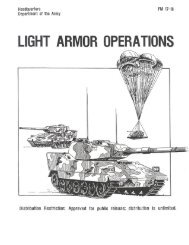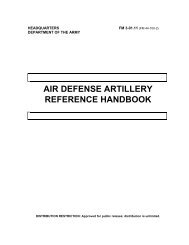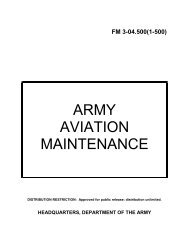fm 44-100 us army air and missile defense operations
fm 44-100 us army air and missile defense operations
fm 44-100 us army air and missile defense operations
Create successful ePaper yourself
Turn your PDF publications into a flip-book with our unique Google optimized e-Paper software.
FM<strong>44</strong>-<strong>100</strong><br />
5-24<br />
• Snowman. Attack is not likely. Enemy <strong>air</strong>craft <strong>and</strong>/or <strong>missile</strong>s are<br />
more than <strong>100</strong> km from the boundaries of a unit AO <strong>and</strong> no tactical<br />
ballistic <strong>missile</strong> launch are detected.<br />
RULES OF ENGAGEMENT<br />
5-103. Rules of engagement (ROE) are the positive <strong>and</strong> procedural<br />
management directives that specify the circumstances <strong>and</strong> limitations under<br />
which forces will initiate or continue combat engagement with encountered<br />
forces. The JFC approves the theater ROE. These established ROE enable<br />
the AADC to retain control of the <strong>air</strong> battle by prescribing the exact<br />
conditions under which engagements may take place. ROE apply to all<br />
warfare participants in the theater <strong>and</strong> are disseminated to all echelons of<br />
<strong>air</strong>, l<strong>and</strong>, <strong>and</strong> sea forces. There are seven ROE categories. The first three<br />
ROE are applicable to all <strong>air</strong> <strong>defense</strong> contributors. The others are primarily<br />
for ADA forces. The seven categories of ROE are as follows:<br />
• right of self <strong>defense</strong><br />
• hostile criteria<br />
• weapon control stat<strong>us</strong><br />
• level of control<br />
• modes of control<br />
• autonomo<strong>us</strong> <strong>operations</strong><br />
• fire control orders<br />
Right of Self Defense<br />
5-104. Comm<strong>and</strong>ers at all echelons have the responsibility to take whatever<br />
action is necessary to protect their forces <strong>and</strong> equipment against <strong>air</strong> or<br />
<strong>missile</strong> attack. When under attack, the right of self-<strong>defense</strong> takes precedence<br />
over any other established rules <strong>and</strong> procedures that normally govern<br />
engagements. Self-<strong>defense</strong> <strong>operations</strong> allow friendly units to defend<br />
themselves against direct attacks or threats of attack through the <strong>us</strong>e of<br />
organic weapons <strong>and</strong> systems. The right of self-<strong>defense</strong> is inherent in all ROE<br />
<strong>and</strong> weapon control procedures.<br />
Hostile Criteria<br />
5-105. Hostile criteria are basic rules that assist in the identification of<br />
friendly or hostile <strong>air</strong> platforms (FW/RW <strong>air</strong>craft, CMs, UAVs). These rules<br />
are promulgated by the comm<strong>and</strong>ers of unified comm<strong>and</strong>s <strong>and</strong> by other<br />
appropriate comm<strong>and</strong>ers when so authorized. The comm<strong>and</strong>er who<br />
establishes hostile criteria parameters may consider the factors of speed,<br />
altitude, <strong>and</strong> heading or other requirements within specified volumes of<br />
<strong>air</strong>space. The comm<strong>and</strong>er may also consider specific threat characteristics or<br />
hostile acts. Echelons having identification authority <strong>us</strong>e hostile criteria to<br />
determine the identification of detected <strong>air</strong> targets. The highest echelon<br />
capable of managing engagement <strong>operations</strong> normally retains identification<br />
authority. Upon target detection, fire units with near-real-time data<br />
transmission capability assist the controlling authority by forwarding target<br />
information. The controlling authority makes final target identification <strong>and</strong><br />
will delegate engagement authority. Delegation of the controlling <strong>and</strong>











